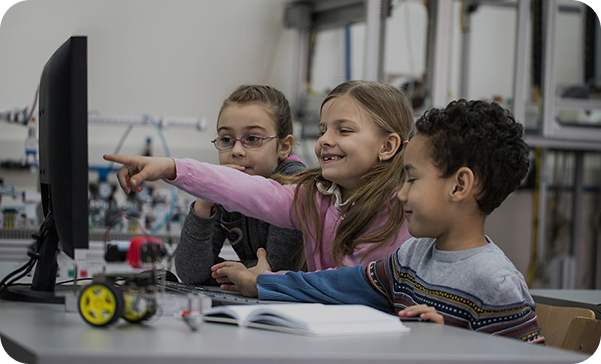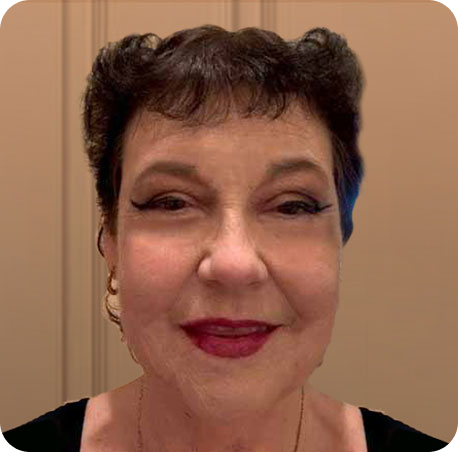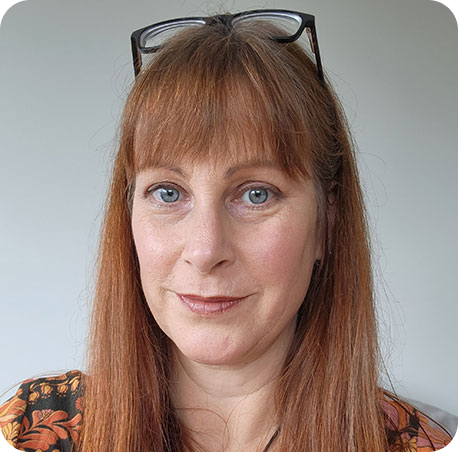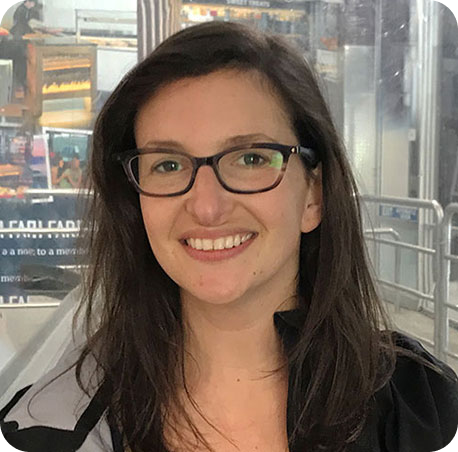
The term Computational Thinking can be quite overwhelming when we first hear or see it in context with learning. I know it overwhelmed me and I spent many hours researching and observing, talking to colleagues and teachers, reading and building up tools and resources to help support my understanding of Computational Thinking. In this article, I’ll share some of my top findings around Computational Thinking, including what it is, why it’s important and how it might look in the teaching and learning environment.
What is Computational Thinking, and why is it important?
Computational Thinking is a process for solving complex problems through understanding what the problem is and breaking it down into smaller, manageable parts. These smaller problems are then easier to break down, often through pattern recognition and abstraction, or focussing on the relevant details and ignoring the irrelevant information. Once an overall solution has been discovered, a set of rules or instructions can then be created and presented in a way a computer, a human, or both can understand.
Computational Thinking is suggested to:
One of the most important aspects of CT is that it enables students to make the leap from consumer to creator. Hence the connection to the new Digital Technologies Curriculum and Progress Outcomes.
“The digital curriculum is about teaching children how to design their own digital solutions and become creators of, not just users of, digital technologies, to prepare them for the modern workforce."
— Chris Hipkins, 2018
The above diagram shows why CT is so important for students of today. A lot of the practises shown align with requirements for the employees of today. We are thus being very future focussed for our students by integrating the Computational Thinking process into our curriculum as well as specifically into the teaching and learning.
01 Decomposition
Decomposition is the process of breaking a complex problem down into smaller parts to help find a solution. This can be especially useful for problems which can not be solved instantly as an overall solution requires several small answers combined together.
Example: Baking a Cake
Before we can go ahead and make a cake, we first need to know:
This encourages: collaborative learning, easier more manageable parts, makes finding a solution less overwhelming for students, encourages reading and understanding the problem first… I’m sure you can see where this is happening in your classroom programme.
02 Pattern Recognition
Looking for and finding similarities and trends within a problem. How does it help us to be able to spot repetition? If we can identify similarities, we can then treat all instances in the same way, saving us time by being able to simply duplicate the same solving technique across all similarities. The more patterns you can find, the faster and easier the task will be.
Example: Decoding a Secret Message
When decoding a secret message, we may see repeated groups of symbols, numbers, etc. Once we have worked out the solution for a particular group of symbols, we know straight away that everytime we see that specific group of symbols, the solution will be the same. Being able to recognise patterns helps us become more efficient problem solvers.
03 Abstraction
Abstraction is the process of taking out all the details that don’t matter that much, allowing you to focus on just the details that do. Doing this will save time, make us more efficient and improve our problem solving abilities.
Abstraction:
Example: Writing a Movie Synopsis
If you ask your students to write a blurb or synopsis of a movie, you would expect them to pick out key parts and not just transcribe everything that happened in the film. They would need to identify and focus on only what’s important.
04 Algorithmic Design (Testing and Debugging)
Algorithmic Design is coming up with a set of step-by-step instructions or rules to follow in order to solve a problem. This is a plan that you put together after having gone through the other cornerstones or foundation process. Your plan must give a starting point, instructions, and a defined finishing point. The instructions to get from one point to the other must be:
Instructions help highlight the importance of providing an accurate sequence, or order of events, and quite often can be represented in flow diagram form.
Example: Teaching a Robot to make Tea
Write a set of instructions for making a cup of tea. The catch: you will be giving these instructions to a robot. This is a fun activity to do and is more complex than you think. Once you have your instructions ready, get someone to test them and continue to tweak until all the bugs are fixed.
If students are practised in this process and begin to use these skills, tools and strategies intuitively, it will:
For more information about the Digital technologies and the technology learning area, check out https://elearning.tki.org.nz
Our team can help. Get in touch to chat with a TTS facilitator about what CT PLD might look like at your school.

I have been working for TTS for the past 7 years assisting schools with their technology infrastructure and digital alignment with the MoE.
Before that I was completing a Batchelors of Business with a major in Management and a Graduate Diploma in Business Administration, I worked in Massey University tutoring, relief lecturing, and marking in the business college while also being a director of a small software company. I also previously held roles as sales manager in the corporate world.
Within the professional learning environment, I specialise in assisting schools with strategic management, change management and leadership. These are all challenging areas that often require specific planning and implementation. Change is not only synonymous with technology but is part of the daily environment in education and embracing change can be a daunting. My goal is to assist schools to feel comfortable and accepting of necessary change.


I am a graphic and digital designer with nearly 20 years experience designing for the digital realm. I have a Bachelor of Fine Arts in Visual Communication, a Certificate in Computer Engineering and am a certified Adobe Creative Educator.
I am passionate about using technology to bring ideas to life and love encouraging learners to look for new ways to answer old questions. As a life-long learner myself, I always enjoy trying out new creative tools and exploring the impact they can have on students’ learning outcomes.
I am excited to be part of the TTS team and continue to help schools make the most of their websites and support teachers and students in creating engaging graphics, presentations, videos, websites, and more.

I’m a teacher with 20 years of classroom experience in a range of schools, locations, deciles and age groupings. I have background in technology education with a specialisation in Food and Material Technology.
I am passionate about technology education. So much so that it lead me to complete a Masters and PhD in Education qualifications where I explored communities of practice, teacher pedagogy and defined technological food literacy. I believe that many hands make light work, and networking and collaboration are key tools in the teacher kete.
I am currently part of the Subject Expert Group working with the Ministry of Education on the Review of Achievement Standards project.
I am a primary trained teacher with over 20 years’ experience finding new ways to effectively implement digital technologies into the classroom. I have always been passionate about finding and utilising digital tools within my class, and I enjoy exploring the internet to find new tools and learn about new ways in which other educators use digital technologies to best support their students.
I believe that is it important to find the right tools for you and your students as every class and school is different. Digital tools and technologies change rapidly and what may not have been suitable in the past could be just what you need now. I look forward to working with and supporting you to find and implement the best digital technologies for your specific learning environment.
I am a specialist teacher and PLD provider of creative writing, drawing on 20 years’ hands-on experience in the primary classroom teaching years 0-6, and as literacy leader, ALL teacher and CoL teacher.
In addition to my classroom experience, I bring my own experiences as a creative writer to my PLD sessions. I have published over 100-chapter books and 9 novels. Much of my published content is for the education market in NZ, Australia, the U.S, U.K and China. Publishers include Macmillan, Pearson, Oxford University Press, Capstone, Lift education, Sunshine books and Cengage. In addition, I have written several assessment and comprehension guides as well as books on how to teach creative writing (Essential resources). I hold a Doctorate in Education (EdD), where I investigated how primary school teachers teach creative writing, often focusing on the use of digital technology. As well as education and teaching qualifications, I also hold a Masters in Creative Writing.
I can provide individual hands-on modelling and feedback, as well as whole staff PLD. In addition, I examine the potential of new media (technology) in creative writing pedagogy.
I am a primary teacher of 30+ years experience covering all year levels from 1-8. I believe in “lifelong learning” and am passionate about encouraging teachers to be facilitators of their learning, and that of their students. I believe knowing when, what, why and how to implement digital tools to fit the purpose of “the teaching and learning” is essential today. I believe relationships are intrinsic in education, connecting people with tools/resources for teaching and learning, and how they support creativity, collaboration and innovation.
Michael is a teacher with 8 years classroom experience, and has taught students from years 1 through to 8. He has a bachelor of teaching and continues to learn through post-graduate studies. Michael is passionate about literacy education, and how reading and writing can – and should – be made accessible and interesting for all learners in schools. As a teacher, he recognises the need for resources that engage, enable, and empower students so they can achieve a meaningful, successful, and sustainable education.
I am an MoE Accredited PLD facilitator with a BEd (Hons) Degree in Education. I have over 20 years of experience in teaching 11 to 18-year-olds, with the last fourteen years being in New Zealand. I believe in empowering teachers to be confident in a modern learning environment and to discover new ways of inspiring students. I am a firm believer of continuous improvement in the skills of a teacher to deliver a more interactive, productive and engaging experience. I am extremely skilled with Google Suite/Apps and Microsoft.